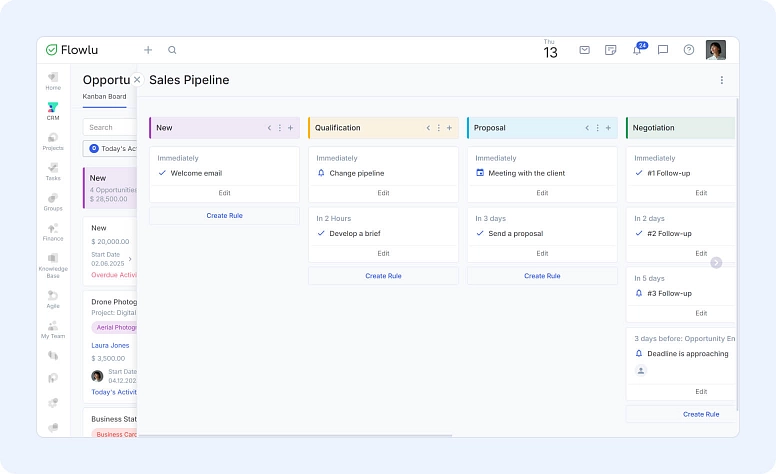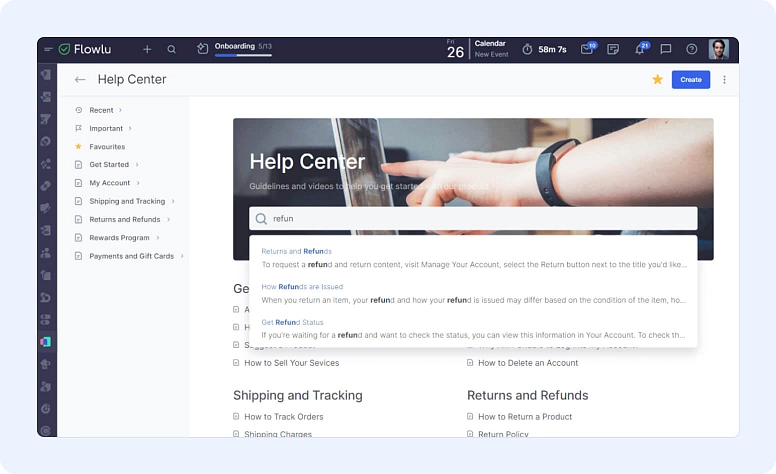The Ultimate Client Onboarding Guide in 2025
More and more companies and businesses are putting the emphasis of their work on customers. After all, without customers, they wouldn’t even have a business. So, it’s natural that customer onboarding is a new expression among the conversations of business owners.
Coming up with a new client implementation process doesn’t need to be difficult. The key is to focus on effective customer and corporate client onboarding to streamline the entire process.
What is Customer Onboarding?
At this point, you may be trying to first discover what client onboarding is, and understand not only what does client onboarding mean but also what is client onboarding process. The truth is that client onboarding definition is very simple and easy to understand. When you want to define client onboarding, you can say that onboarding of new customers is the way you have to show your new customers the value of your service or product.
If in the old days business owners thought their work was done when the customer bought their service or product, this is no longer the case. The truth is that the relationship between new customers and your business is just starting. It’s important to keep in mind that the period after the purchase is very important for buyers. After all, it’s normal that customers need some kind of guidance to make the most out of their purchase.
We don’t have to tell you that first impressions matter a lot in life, and in business it is no different. That’s why it’s important to have a clear and structured onboarding process. This includes best practices for new customer onboarding, a well-defined marketing client onboarding strategy, clear steps, a timeline, and a workflow—all outlined in a comprehensive client onboarding guide.
The Importance of Client Onboarding
As we already mentioned above, customer onboarding is crucial to establish a long relationship with your customers. You want to make sure that the new user onboarding runs flawlessly and smoothly. Here are some of the most important reasons why new customer onboarding is so important:
#1: Get a Deeper Understanding:
When you have an online customer onboarding strategy in place, you’ll get to know your clients better. You’ll know more about your users expectations, goals, and needs. This will allow you to serve them better now and in the future. The client onboarding journey will serve as a guide to you as well. It’s an opportunity to see any pain points that exist and overcome them, as well as continue to deliver what is making your strategy successful. Improving the customer onboarding team should always be your goal.
#2: More Efficiency:
Having a customer on boarding well implemented, allows the integration of new customers process to be streamlined. Errors will be minimized as well as confusion. An onboarding process for new clients is an effective tool to learn how to use your tools more efficiently.
#3: Improved Client Satisfaction:
Online client onboarding will help your customers feel appreciated, valued, and welcomed. This is the first thing they will feel which means they will be more likely to buy from you again in the future.
#4: Build Stronger Relationships:
When you use a new customer onboarding, you are building a relationship with your customers based on trust. Since your customers feel your support, they’ll become loyal to your business.
The Customer Onboarding Process Flow
Here are the 6 client onboarding process steps you should take when you are defining a client onboarding plan:
Step #1: The Sign-Up Process:
This step should be as simple, short, and smooth as you can. Don’t try to ask for too much information or questions. An email address, name, and password is more than enough. However, in case you want to ask for more information, try to make it just in one page or spread it over a few pages but always display a progress bar at the top. This will let your customers know how the process is going.
Step #2: The Welcome Email:
As soon as a new client signs up for your service or product, he should receive a welcome email from you. In this email, you should include all the details about the service or product they just bought as well as any tips to use it the best way. Add links to your FAQs, a demo video, product tours, knowledge base articles, or any other material that may be relevant.
Keep in mind that you should take the time to say thank you to your clients for buying from you.
In Flowlu, you can automate welcome emails to clients as soon as they submit a form on your website.
Step #3: The First Time The Customer Uses Your Service Or Product:
This is a key step and you shouldn’t rely on guesswork. Make sure that you tell your customers exactly what they need to do to start using the service or product. You may add a setup wizard if it makes sense for your business, for example. Another idea is to come up with a checklist where your customers can see what they have to do during the service onboarding process.
Step #4: For B2B Companies:
While adding some setup wizards or teaching how your clients can use your service or product may be easy, when you have a B2B company, it may be a bit more difficult to make the corporate customer onboarding but it is possible.
If this is your case, you need to start providing as many options as you can. Just put yourself in the shoes of your customers and think about what they need. For example, inviting others to join the team, import data, or set up integrations may not be necessary for everyone. This means that you may have a skip this part button added. Another idea to keep in mind is to use automation whenever you can. This will help remove bottlenecks that can cause issues to your customers.
As always, you should strive to provide the best support you can.
Step #5: Set Up A Tutorial Or Walkthrough:
Setting up a tutorial or walkthrough is the next step of the customer onboarding. Even though you may believe that starting using your service or product is a piece of cake, your customers may not feel the same way. So, you want to make sure they can start using it without delays and bottlenecks. Coming up with a tutorial or walkthrough is a good solution to maintain your customers happy with their purchase. However, there are some things you should keep in mind. For example, allowing your customers to skip or repeat some parts of the process may be helpful.
Putting the tutorial on pause should also be an option even if your client logs out. When he logs in again, he should be able to continue watching the tutorial where he was and not start at the beginning again, unless he wants to.
A final thought to consider is that even though you may think you covered all aspects in this tutorial and walkthrough, you should still allow your customers to get in touch with your customer support for extra help. You may, for example, include a chat in this same page to be easier.
With Flowlu, you can use the chat to communicate directly with your customers and ensure they can continue using your services and products without problems or delays. But that’s just the beginning—Flowlu also lets you create an external knowledge base for customers, providing self-service resources at their fingertips. Plus, you can streamline onboarding with built-in checklists, allowing you to set up step-by-step guides directly inside your client portal for a smoother user experience.
Step #6: Follow-Ups Are Crucial:
If you think your work is done, you’re wrong. The truth is that following up with your customers is crucial to ensure they continue engaged with your business or company.
In follow-up messages, you should avoid making it all about sales. Instead, share the resources you have ready for your customers and that also indicate they can upgrade their products or services, for example, In your messages, brief and concise is better than long and exhaustive. Your customers don’t want to spend their time reading your messages. They want to get the most out of the service or product they purchased.
Another thing you can use in your follow-ups is to add some social proof. You can share some reviews or testimonials with your customers. Remember that there is always room to improve your onboarding.
7 Customer Onboarding Best Practices
It’s not easy to come up with a complete onboarding process. You need to think about what you want to create and what your customers may need.
Now that we already defined what is customer onboarding process, here are some best practices and practical tips to ensure that you have a streamlined user onboarding strategy in place:
#1: Who Handles The Onboarding Process:
It’s important to have someone or some team in charge of the onboarding of customers. In case you prefer, you may have responsibility spread for different teams. For example, you may have some team responsible for managing customer relationships, another team responsible for writing and designing the content, and still another team responsible for organizing and running training sessions.
In case you have a small business, you may have only one person in charge of the entire process.
One of the thighs that can help you set up the best client onboarding process is to use a client onboarding process template.
#2: Determine The Onboarding Process Goals & Milestones:
You already know the huge benefits a good onboarding new clients process can bring to your business. However, it’s also important to set clear goals and milestones that you want to achieve within the overall customer onboarding plan and maybe within some customer onboarding steps. You may define that a specific percentage of customers sign for a paid plan after using the free trial, for example.
#3: Define The Onboarding Model:
Depending on your own business, service or product, and customers, you need to choose between 3 different onboarding models to achieve customer success:
- Low-Touch Model: It tends to include automated email campaigns and chat support. However, there are no support reps.
- High-Touch Model: This model needs more resources since it looks for each customer's needs. It tends to include dedicated customer support reps and personalized strategies of onboarding.
- Self-Service Model: If you’re the owner of a simple business, this is probably the best model for you. After all, the customer is the one who decides when and how he wants to use your service or product. He will take a look at the resources available when he wants and at his own pace.
#4: Create A Review System:
One of the things that you should keep in mind about onboarding processes is that they’re never complete. There is always room to improve. In fact, as you get to know more about your customers, it’s natural that you start to change some things here and there.
One of the ways to ensure that you’re still offering the right customer onboarding journey is to keep good communication with both your internal team and your customers. This way, you’ll notice that you need to make changes.
#5: Changing Is Natural:
This is one of the most important client onboarding best practices. Many business owners think that after defining their client onboarding program, it is done. However, this is hardly the case. Even though it may take some weeks or months to make the first changes, these changes are natural and need to be seen like that. Customers change; their goals or expectations won’t always be the same. You just need to adapt your process to these changes.
It’s always important to keep in mind the customer onboarding to ensure that you provide the best experiences. It’s essential that you look at your onboarding strategy that you’re using, look at the customer onboarding training and guide, and compare them with user onboarding best practices. Determine what you’re missing.
It may be something related with a new product onboarding process, an old product onboarding process, or you might be missing a client onboarding team, or a client onboarding flow that allows a better engagement.
#6: Multiple Ways To Get Customer Service Onboarding Process:
You should always have multiple options available for customers to get help. Even though you may already have set a customer success onboarding plan with exceptional customer service, you should also have a help desk system, a chat, or a call system for example. A new account onboarding process should be able to access all the support options.
With Flowlu, you can define the support email inside the platform as well as you can add a chat to your page and help your customers immediately.
#7: Build A Knowledge Base:
Building a knowledge base doesn’t need to be difficult or hard and it can definitely help with onboarding and customer success. You just need a good tool on your side like Flowlu. Add the documentation and any other files you want easily.
Bottom Line
You already know how important customer onboarding is. It’s your customer’s first real experience with your product or service, and first impressions matter. A smooth onboarding process helps you start on the right foot, making new customers feel welcome and engaged—which, in turn, builds loyalty.
Even if you’ve never set up an onboarding process before, there are plenty of examples online to guide you. The key is understanding your customers and following a clear onboarding plan. Once you have a structured workflow in place, focus on delivering a great experience by following best practices for product onboarding and ensuring a strong support system, like a well-defined customer success strategy.
There are 3 main stages: primary, secondary, and tertiary. The first one is used to show the customer the value of the service or product he just purchased. The secondary is used to show the additional value of the service or product, and the last stage is used to strengthen the relationship with customers.
As you can easily understand, there are many different metrics you can use. From measuring the customer engagement to looking at the rate of conversions or the rate of upgrades, you can get clues on different metrics to see how your onboarding is going.
Regularly review customer feedback, track onboarding completion rates, and identify any common pain points. Automate repetitive steps, provide clear instructions, and offer multiple support options like a knowledge base or chat support to make onboarding smoother for new clients.




















